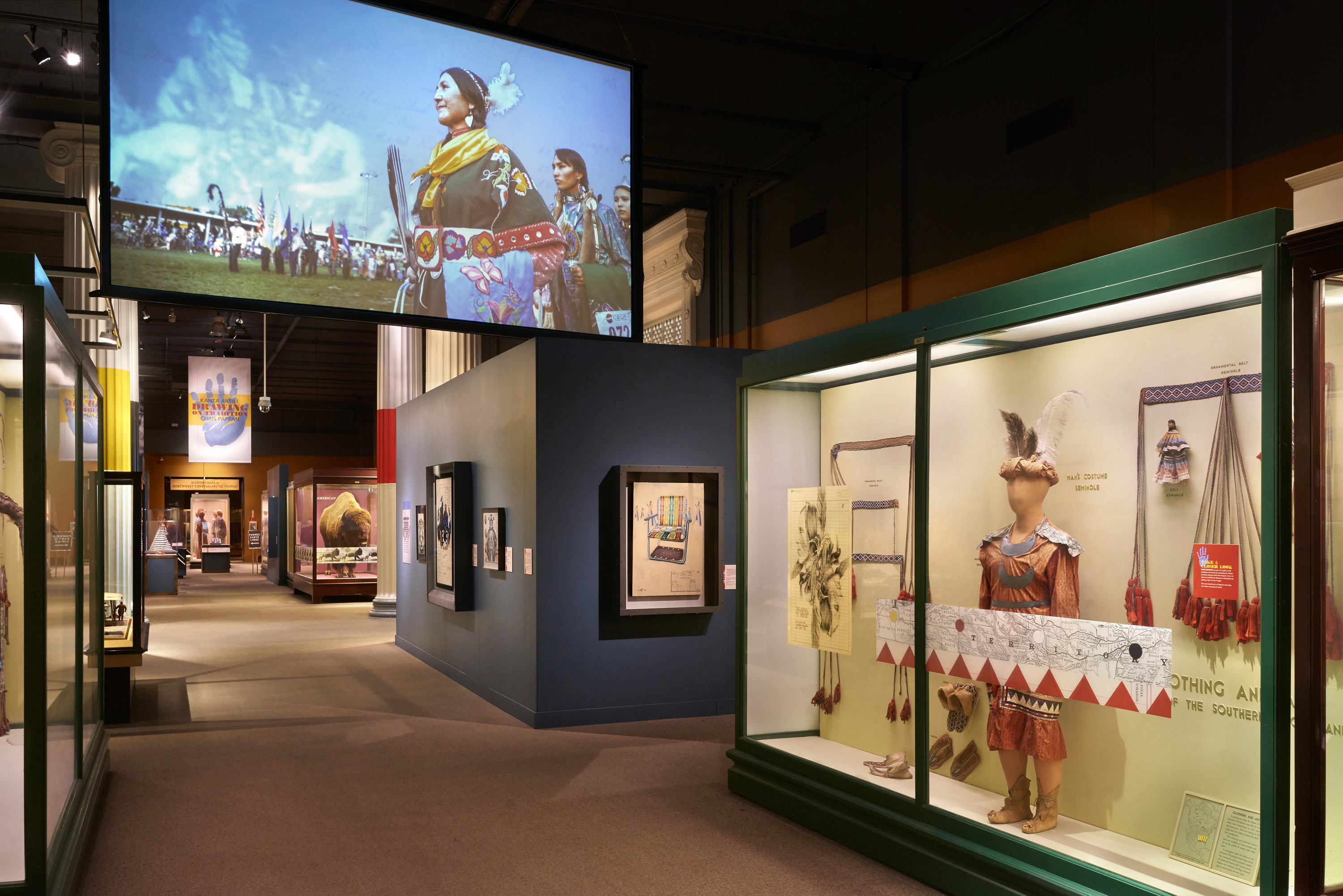Little has changed in the Field Museum’s Native North American Hall’s displays since the 1950s. Faceless mannequins dressed in headdresses and moccasins, beadwork, hide paintings, spearheads, and textiles are all encased behind glass. Complete with midcentury typefaces and muted pastel backdrops, the exhibit gives the impression of being frozen in time.
The case labeled "Indians of the Chicago Region,” for instance, makes no mention that the greater metropolitan area now has the nation’s third largest Native American urban population. This restricted view can be traced back to the museum’s beginning. Native American objects acquired for the 1893 World's Columbian Exposition by anthropologist Franz Boas — who believed he was salvaging remains of disappearing cultures — were part of its founding collections.
After six decades of this static display, the tribal nations connected to these objects will finally have a voice in their presentation, emphasizing their place in living culture. In October, the museum announced a three-year renovation of the hall. When it reopens in 2021, it will not just represent a new direction for the Field Museum but will reconsider what natural history museum ethnographic galleries can, and should, be in the 21st century. The challenge is in recognizing the colonialism in their roots while involving indigenous voices that have long been left out.
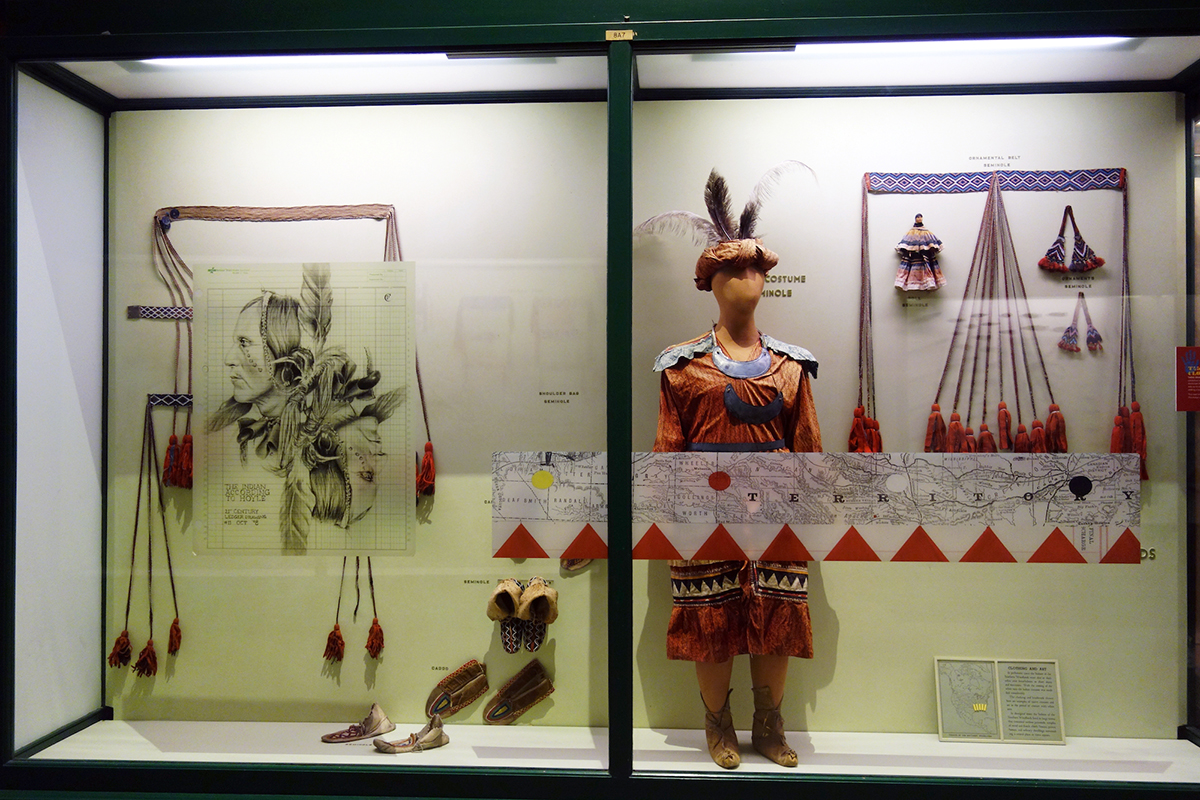
One Chicago-based Kanza artist, Chris Pappan, has temporarily installed transparent overlays on the old cases that bridge these two narratives. His drawings and paintings, created in the style of ledger art, obscure the outdated displays or offer new ways of viewing the objects.
“At the time [of the exhibit’s opening in 2016] the hall hadn't risen to the top of strategic priorities in the museum,” says Alaka Wali, the museum’s curator of North American anthropology. “Seeing Chris’s exhibit in there, and understanding the way that he was able to highlight the power of the objects, but also their problematic representation, spurred the museum to say, ‘We need to renovate this hall more urgently than we thought.’”
Drawing on Tradition: Kanza Artist Chris Pappan follows Wali's 2013 co-curation of a show with Pawnee artist Bunky Echo-Hawk, who chose museum objects like a 19th-century Ghost Dance dress to be displayed with his pop culture-sampling paintings. In a gallery next to Pappan’s installation, Lakota artist Rhonda Holy Bear has her intricately beaded figures arranged alongside artifacts that inspired her work.
Each of these art interventions recontextualizes the Field Museum collections, honoring the importance of these objects and drawing attention to the often limited ways they’re presented in natural history museums. Pappan’s exhibition is the first to directly interact with the framework of the galleries.
“I hadn’t spent much time before in the hall because honestly, the state it was in was very depressing, and it was sad seeing the neglect,” Pappan says. “So when I was given this opportunity, I was really looking forward to bringing new life into the hall, and to show people a contemporary Native American viewpoint.”
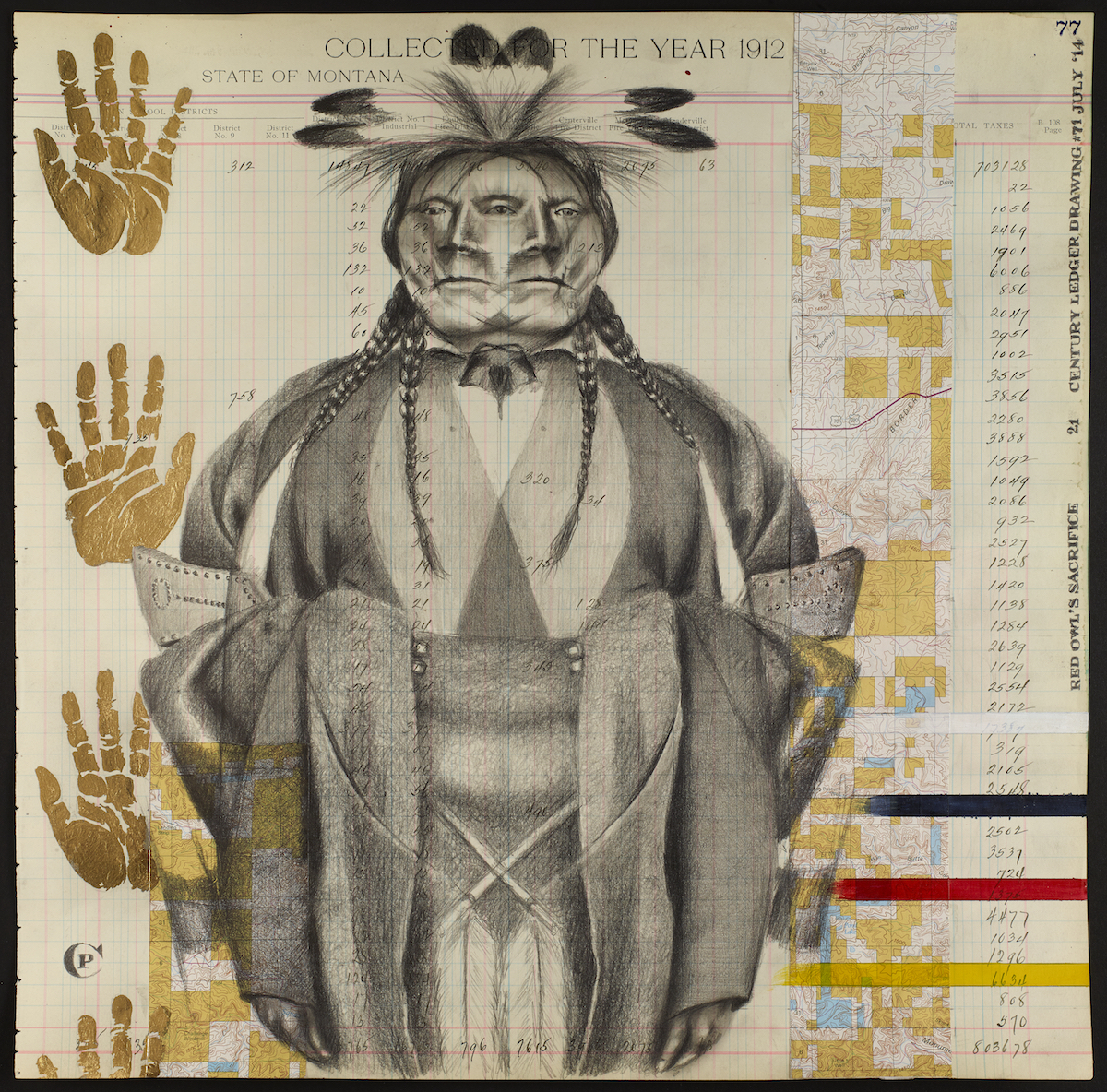
As co-curator, Pappan spent time researching in the museum, in particular examining its Plains ledger art. In the 19th century, during forced relocation following the Indian Removal Act of 1830, pictorial narrative art formerly produced on hide was sketched on paper ledgers. Some well-known examples include the illustrations of battles, winter counts, customs, and dreams by prisoners of war at Fort Marion in St. Augustine, Florida.
Pappan reinterprets this traditional art, layering graphite illustrations over found antique ledger paper, sometimes collaged with maps. In these drawings he distorts or mirrors portraits of historical figures like Mohawk vaudeville star Esther Deer, who exoticized herself to make a living in Wild West shows, and Cleaver Warden, an Arapaho translator who worked in the early 1900s with anthropologist and Field Museum collector James Mooney.
Some of these transparencies allow visitors to see through them to the encased objects; others are opaque. Circling the display of a taxidermy American bison is a strip that depicts a buffalo photographed by Eadweard Muybridge, galloping on maps of the Southwest. It reminds that the landscape was once home to many of these animals, alive and running.
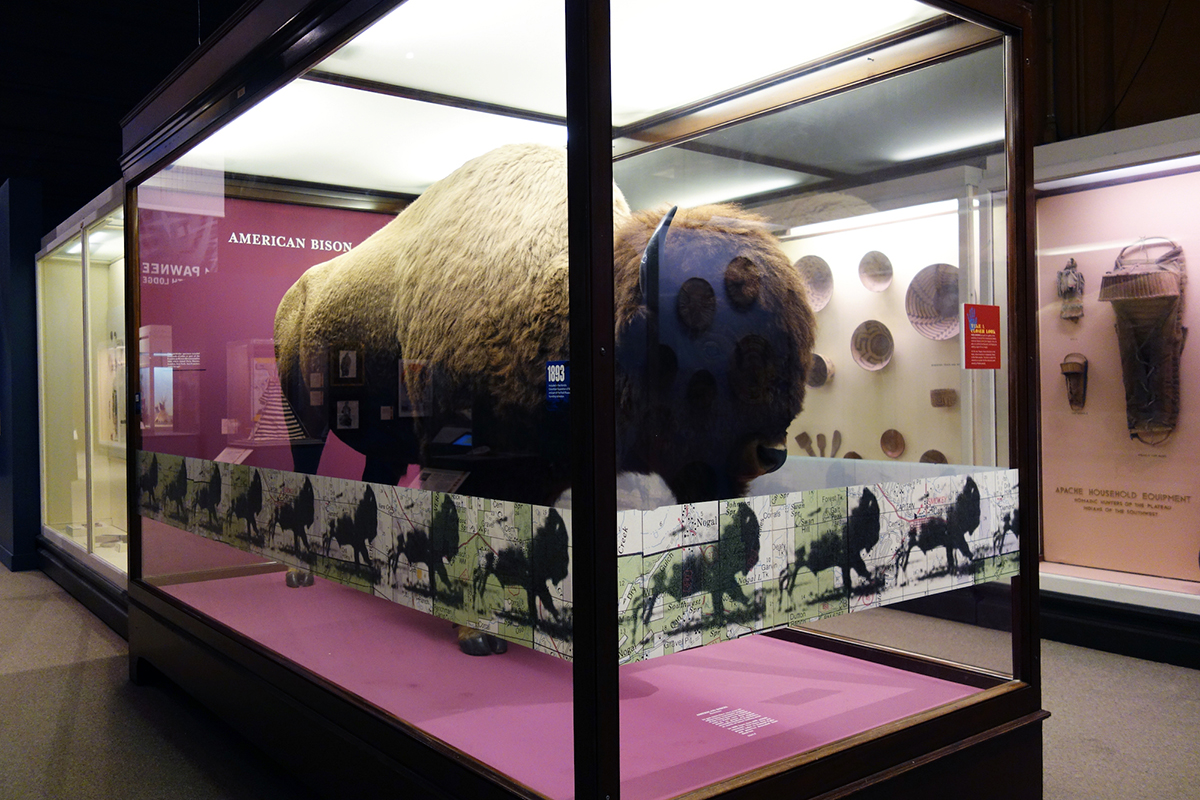 Installation view of Drawing on Tradition: Kanza Artist Chris Pappan at The Field Museum PHOTO: ALLISON C. MEIER
Installation view of Drawing on Tradition: Kanza Artist Chris Pappan at The Field Museum PHOTO: ALLISON C. MEIEROn another case that holds weaponry, Pappan has added a semi-transparent image of a woman, viewed as if through a fisheye lens, labeled with the text, “Thank You, Grandmother.” This image is placed next to a sliver of map titled “TERRITORY” — a slice of today’s Oklahoma, formerly the Indian Territory where indigenous people were relocated. The paired overlays resist both the display’s presentation of a people stuck in the past and the federally led oppression that fueled the museum’s early collecting.
Also on view in the hall is a multimedia video Pappan created in collaboration with photographers Adam Sings In The Timber and Debra Yepa-Pappan, with music by Santiago X. A looping electronic beat with samples from a 1983 Nebraska powwow accompanies 1894 footage attributed to Thomas Edison of three Sioux dancers, remixed with contemporary portraits of Native Americans. The pulse of the music and the rhythm of the video makes the whole hall — even the spaces untouched by Pappan’s art — feel alive.
While Pappan’s exhibition closes on January 21, the Native North American Hall will soon be invigorated with new energy, through a project led by an advisory committee of indigenous scholars and museum professionals. Encased objects will be properly conserved after years behind glass (and the committee will address that natural materials were, in the past, treated with poisonous pesticides). The hall will showcase material from the Field's collections alongside contemporary objects, co-curated with community members and Native American scholars. While its final form is still being developed, the new display will emphasize contemporary narratives through spaces for rotating exhibitions and, most importantly, foreground an indigenous perspective on this heritage.
Notably, the museum also hosted a ceremony last October to recognize that it stands on the homelands of the Ojibwe, Odawa, and Potawatomi; the acknowledgement is marked by a new plaque in its garden.
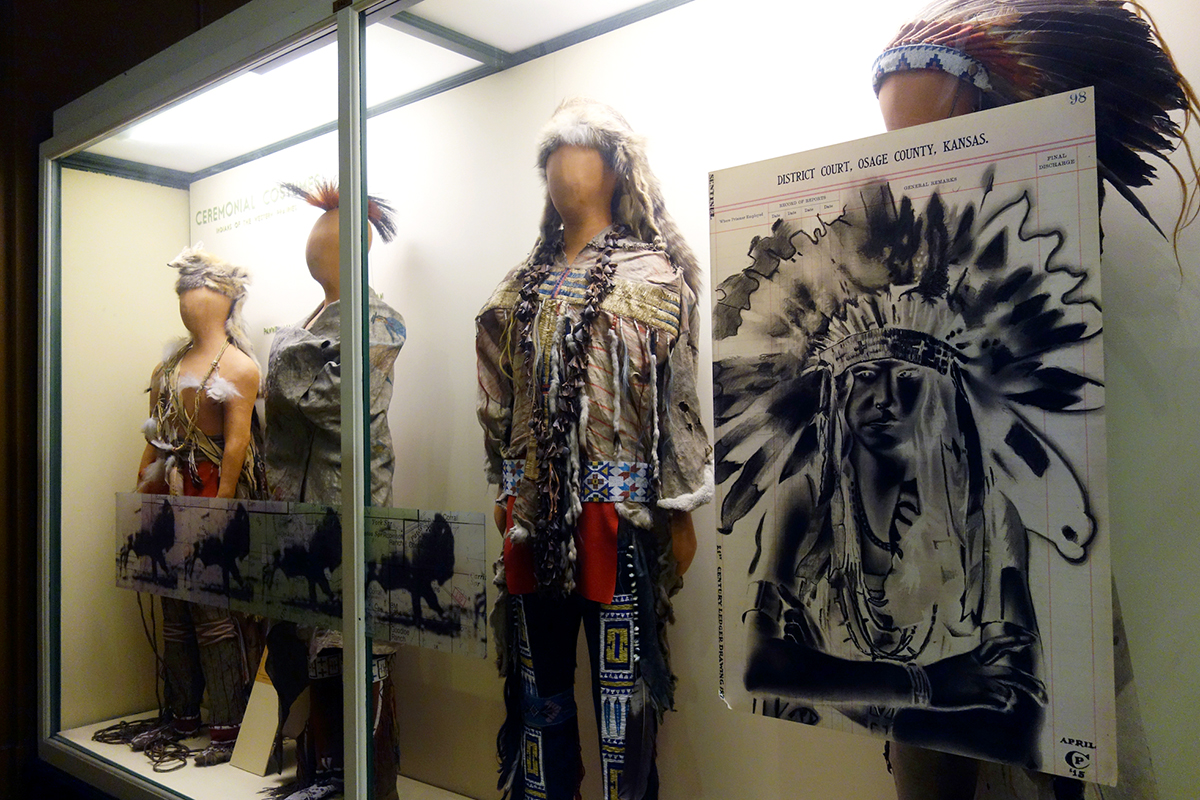
Installation view of Drawing on Tradition: Kanza Artist Chris Pappan at The Field Museum Photo: allison C. meier
It's worth questioning whether natural history museums should still have anthropological galleries. When many of these museums were established in the 19th century, European heritage was enshrined in art museums, whereas the cultures of the rest of the world were often treated as obsolete curiosities to be displayed alongside dinosaur bones and taxidermy animals. For Native Americans, their heritage was acquired by museums at the same time white settlers seized their homelands.
But the various steps the Field is taking move towards some healing as they elevate voices that have been marginalized throughout these institutions’ lifetimes.
"It has been such an honor to know that my work was a catalyst for the renovation of the hall, and I am eager to see what happens in the future," Pappan says. “The museum has already begun to de-install cases, and when I first saw those empty cases it was a huge relief, knowing that those pieces are now going to be handled with care. It was also a very real step forward by the museum to show their commitment to change.”
Drawing on Tradition: Kanza Artist Chris Pappan runs through January 21.




